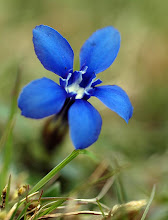

 This little organism, about a tenth of a millimetre in diameter, is an alga called Stephanosphaera pluvialis. It’s almost always found in bird baths and this one came from the gutter around our conservatory roof , which is always full of water and is regularly used for bathing by the birds in our garden. Stephenosphaera consists of eight photosynthetic cells, each with two lashing flagellae, encased in a gelatinous sphere that’s a clear as glass. Driven by the flagellae, the whole organism rolls through the water (see rather shaky video clips) - eight tiny cells in their gelatinous survival capsule, on an endless journey through the oceans of our conservatory gutter. It's carried from place to place on the feet and plumage of birds.
This little organism, about a tenth of a millimetre in diameter, is an alga called Stephanosphaera pluvialis. It’s almost always found in bird baths and this one came from the gutter around our conservatory roof , which is always full of water and is regularly used for bathing by the birds in our garden. Stephenosphaera consists of eight photosynthetic cells, each with two lashing flagellae, encased in a gelatinous sphere that’s a clear as glass. Driven by the flagellae, the whole organism rolls through the water (see rather shaky video clips) - eight tiny cells in their gelatinous survival capsule, on an endless journey through the oceans of our conservatory gutter. It's carried from place to place on the feet and plumage of birds. 







































